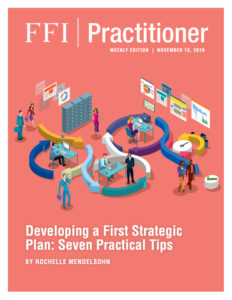
View this edition in our enhanced digital edition format with supporting visual insight and information.
According to Mark Twain, “The secret of getting ahead is getting started.” In that light, we are pleased to share an article by Rochelle Mendelsohn that explores the reasons why family enterprises without a strategic plan should consider developing their first and outlines seven tips for advisors working with these organizations throughout the process.
“You would think…” It’s a phrase that warns an assumption is about to follow, and often that assumption can be faulty or an over-simplification. One such faulty assumption is, “You would think a profitable, growing second or third generation family enterprise would have engaged in strategic planning along the way.” It’s more common than many think to encounter a family enterprise with a 30, 40 or 50-year history facing changing conditions that prompt its leadership to consider developing a strategic plan for the first time.
Changes that motivate an enterprise to consider developing its first strategic plan may be internal – related to ownership succession, management succession, a cluster of legacy employees approaching retirement at once, a product line facing future irrelevance, innovation drying up, infrastructure become outdated, or a range of other conditions. The motivational changes may also, or alternatively, be driven by external change – stemming from industry consolidation, technology developments, competitive disruption, regulatory conditions, supplier dynamics, economic outlook, or the political environment.
Despite compelling reasons to develop a first strategic plan, the planning process can seem complicated, time-consuming, burdensome, and potentially intimidating. There are multiple strategic planning models to consider using, such as a Balanced Scorecard, OKR (Objectives and Key Results), Porter’s Five Forces, Blue Ocean, and other approaches. There is a lexicon full of ubiquitous terminology, making it difficult for strategic planning newcomers to understand clearly the type of content they will be developing and how they will organize or structure it. References to objectives vs. goals vs. priorities or strategies vs. tactics vs. initiatives create unnecessary confusion around what are often merely different ways of describing generally similar planning concepts. And within family enterprise, there is another layer of complexity related to the intersection of family and business. Specifically, family enterprise leaders may be hesitant to enter into a strategic planning process that will need to address, and therefore shine a light on, challenging family dynamics embedded in the business.
Too often, perceived process complexities can delay or stop an organization from developing its first strategic plan. Yet the power from a plan can only be reaped from a process that begins. General George S. Patton said, “A good plan, violently executed now, is better than a perfect plan next week.” Those of us who lead organizations through strategic planning have an opportunity to simplify and clarify planning expectations, thereby promoting sooner starts and completions of first strategic plans. In that spirit, I offer 7 practical tips for organizations considering development of their first strategic plan.
- Clarify up front how planning decisions will be made and by whom. Understand what types of decisions will be made by ownership and what types will be made by management; what types will be made by groups and what types will be made by individuals. This will help the planning process proceed more smoothly.
- Specifically in family businesses, set clear expectations regarding the roles of family members in the planning process – being explicit about expected participation by family owners who work in the business, family owners who don’t work in the business, and non-owner family members who work in the business.
- Prioritize exploration and development of the vision, which can be a powerful short-term and long-term tool for organizational direction and alignment. Engage in meaningful thought, discussion, and vetting of the vision. Don’t seek perfection in wording the first time you articulate it. Communicate it, live with it, use it to align and energize the organization, and then refine it in future planning.
- Be expansive in the earliest planning discussions. Include participants, perspectives, hypotheses, and ideas that open thinking to the possibilities before becoming wedded to specific futures and paths to those futures. Also, avoid the common pitfall of focusing primarily on the way things have been and that which is already underway in the organization.
- Separate WHAT from HOW. First, identify WHAT the organization intends to accomplish, without getting caught in details and uncertainty related to HOW the organization will accomplish it. This enables more strategic discussion to occur, without limiting goals to only those with known solutions. It also enables greater momentum and progress in the planning process.
- Challenge biases that may limit the organization’s thinking, ideas, vetting, and solutions. One type of bias, confirmation bias, can be difficult to recognize and manage in the planning process. As a tendency to process information by looking for or interpreting consistency with existing beliefs, it essentially places filters on thought, discussion and output, often without planning participants or organizational leaders being aware of it. One practical way to recognize and challenge biases is to ask explicitly throughout the planning process, “What assumptions may be limiting our thoughts, interpretations, ideas or conclusions?”
- Above all, recognize that just as much value, if not more, is derived from the data-driven insights, discussions, and pursuit of alignment during the planning process as is derived from the final plan ultimately developed.
As Mark Twain noted, “The secret of getting ahead is getting started.” Similarly, I propose the secret of unleashing the potential of strategic planning is getting started on the first plan. Future plans will build off the foundation of the first plan, enabling the enterprise to position itself for even greater success over the long-term. It all begins by starting to develop a first strategic plan; and reducing the amount or level of perceived planning process complexity can help an enterprise take that first crucial step.
About the Contributor
 Rochelle Mendelsohn, Managing Director of Strategies, Inc., is a business consultant, strategist and advisor with over 30 years of experience. Her focus is helping businesses translate seemingly complex challenges into simpler frameworks that enable break-through solutions, executional focus and organizational momentum. Rochelle can be reached at rochelle@strategiescorp.net.
Rochelle Mendelsohn, Managing Director of Strategies, Inc., is a business consultant, strategist and advisor with over 30 years of experience. Her focus is helping businesses translate seemingly complex challenges into simpler frameworks that enable break-through solutions, executional focus and organizational momentum. Rochelle can be reached at rochelle@strategiescorp.net.
About Strategies, Inc.
Strategies, Inc., a leader in business planning and advisory services for more than 30 years, is a consulting firm of trusted advisors who help entrepreneurs, partnerships and family businesses develop their visions, realize their goals and control their futures. Since 1976, we have guided our clients through the challenges of business growth and change using an objective, direct and holistic approach customized for each client.

View this edition in our enhanced digital edition format with supporting visual insight and information.





